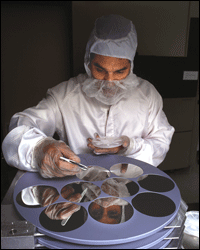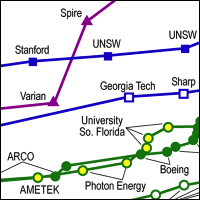
Superefficient, Cost-Effective Solar
Cell Breaks Conversion Records
Dec 8, 2006 David Biello Scientific American
A tiny solar cell doubles the efficiency of common
photovoltaics' conversion of sunlight to electricity
by capturing the energy from a broader spectrum of
light.
 |

|
 |
Image: COURTESY
OF SPECTROLAB |
 |
SOLAR EFFICIENCY:
New solar cells capture more of the energy in
sunlight by layering semiconducting material on
top of germanium wafers, pictured here. |
A tiny chip similar to the solar cells carried by many
satellites and other spacecraft today--including the
surprisingly long-lived Mars Rovers--has shattered previous
records for maximum efficiency in producing electricity
from sunlight. "This is the photovoltaic equivalent
of the four-minute mile," affirms Larry Kazmerski, director
of the Department of Energy's National Center for Photovoltaics
in Colorado. "This is a disruptive technology that eventually
could provide us, at least in the Southwest, with cost-competitive
electricity fairly quickly."
The specifics: a germanium wafer is spun at high
speeds and subjected to various gases that encourage
the growth of layers of semiconducting material such
as gallium arsenide. "We have somewhere between 20
and 30 layers of semiconductor material," explains
David Lillington, president of Spectrolab, Inc., which
developed the new cell. The resulting layers in one
single solar device respond to different spectra of
light. The top layer, for example, captures the energy
of blue light while the middle layer absorbs green
and the bottom uses red. Such triple-junction solar
cells are specially tuned to work with concentrated
light, in this case the wattage of 240 suns.
The resulting efficiency nearly doubles that of standard
silicon solar cells, which hover at 22 percent. That
gain requires, however, the use of light-concentrating
devices, such as miniature plastic lenses and mirrors.
The new solar cell achieved 40.7 percent efficiency
under such concentrated light at the testing center
at the National Renewable Energy Laboratory in Colorado.
One cell of just 0.26685 square centimeter (or roughly
0.04 square inch) pumped out 2.6 watts of electricity
when bathed at the maximum light concentration. "Every
five minutes the spectrum of the sun changes," Kazmerski
explains. So tests are conducted "under a simulator
where everything stays constant."

|
 |
| Image: COURTESY
OF LARRY KAZMERSKI |
 |
| HERE COMES
THE SUN: Various solar technologies
continue to push upward the efficiency of their
conversion of sunlight to electricity. Click on
the picture to see the full graph. |
Even though installed cells would require concentrators,
the fact that fewer cells can produce the same amount
of power--and that similar cells are already widely
produced--means this system could potentially generate
electricity in the range of 8 to 10 cents per kilowatt-hour--roughly
equal to consumer electricity prices today. "Eventually
it's hoped that it will come down enough to rival the
price of traditional energy although that is future
tense," notes Dave Garlick, a spokesman for Spectrolab's
parent company Boeing.
"This could mean a significant increase in the penetration
of solar power," says Clark Gellings, vice president
of innovation at the Electric Power Research Institute,
a think tank. "The real barrier was the cost of the
device." Many utilities have already invested in solar,
including giant solar farms in Portugal and China.
In the U.S., Xcel Energy plans to build a relatively
modest eight-megawatt solar power plant in Colorado
next year using similar concentrated solar cells as
well as other technology. "This is not a technology
that is 10 years away," Kazmerski adds. "This is a
technology that we are going to see out working next
year."
Nevertheless, the record-breaking solar cells are
at least 12 months away from full-scale manufacturing,
Lillington says. "Before we put this new cell into
production it needs to go through a qualification
process to make sure it can withstand the rigors of
the environment." Of course, its Martian peers have
lasted 28 months in that harsh, alien environment.
And the triple-junction solar cell may not hold the
efficiency record for long. "We are also looking at
four-, five-, even six-junction solar cells," Lillington
notes. "There are at least three or four different
approaches to take the efficiency into the 45 percent
range." And that means the price of energy harvested
directly from the sun will continue to drop.

|